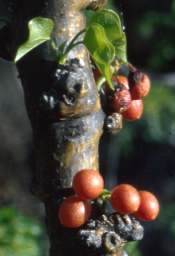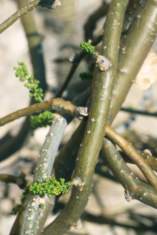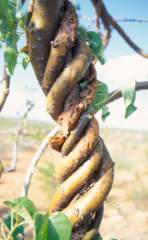Tinospora fragosa
Tinospora fragosa (I.Verd.) I.Verd. & Troupin
Family: Menispermaceae
Common names: Aaron's rod, wonder plant (Eng.); Aaron-se-staf, wonderplant (Afr.)
Introduction
Tinospora fragosa is an amazing and peculiar succulent-stemmed twiner with attractive heart-shaped leaves and red fruits. It is easily grown and thrives in containers in partial shade or outdoors in dry, frost-free, subtropical conditions in full sun.

Description
Description
This is a twining, succulent-stemmed, fast growing deciduous climber with tuberous roots. Its branches are grey-green, up to 40 mm in diameter, becoming brown with age. The green to grey-green leaves are heart-shaped and 100 x 100 mm. The inflorescence consists of false, drooping racemes up to 40 mm long. Its flowers are tiny creamy-greenish and male and female flowers are formed on different branches.

It flowers in spring (September to November). The female flowers are followed by oval red fruit up to 10 mm in diameter. These ripen during summer and autumn and are dispersed by frugatory birds. The plants are long-lived and often locally abundant.
Distribution and habitat
Distribution description
Aaron's rod is confined to dry subtropical regions of the northern parts of Mpumalanga, Limpopo [Northern Province] and the North West in South Africa as well as northern Namibia and Botswana. It occurs in various soil types and is well suited for cultivation but should be protected from frost. Although it can be grown in shady situations, it prefers sunlight.

Tinospora fragosa is a twiner in bushveld vegetation, often growing 10 m or higher, hanging like a snake in trees. The habitat may vary from flat, mountainous to dry river valleys. Temperatures are high during summers with an average daily maximum of 28-29°C and average daily minimum 16-17°C. Winters are cooler but frost is absent or very light. Rainfall is mainly during summer and autumn, ranging between 350-450 mm (mainly thunder showers).
Derivation of name and historical aspects
History
Tinospora fragosa was described by Dr Inez Verdoorn in 1962 from plants collected by Dr F. Z. van der Merwe (1894-1968), medical inspector of schools, with an interest in Aloe, Ledebouria and other indigenous plants. Its species name fragosa pertains to its fragile stems. The latter have a tendency to produce weak and thinner parts in its stems, fragmenting the plant into various vegetative units, each of which can re-root and form new plants.
Tinospora fragosa is immediately distinguished from otherTinospora species by its grey-green, thick, fleshy stems bearing heart-shaped grey-green leaves. It is related to both T. caffra and T. tenera which occurs in Mpumalanga and KwaZulu-Natal. The stems of both these are much thinner, striated in T. tenera and knobbly in T. caffra. The genus Tinospora consistsof about 40 twining species from tropical and subtropical regions.They belong to the Menispermaceae family and all have the amazing ability to form aerial roots.
Ecology
Ecology
Tinospora fragosa plants have the amazing ability (when detached from the mother plant) of forming an aerial root which can grow down from 10 m and more above ground before re-rooting and thus re-establishing the plant. In their native dry bushveld habitat the plants are often disturbed by big game such as kudu and elephants. Instead of dying, the plant simply drops or grows a new "lifeline" re-establishing itself. The root will only appear during the rainy season and the rest of the plant will remain dormant, as its first priority is rooting during the warm, wet season. This solitary root is initially thin (1-1.5 mm in diameter) but once established soon thickens.

The growth rate is also very fast and can reach up to 10-250 mm per day. When a branch is cut up in fragments of 200 mm and longer and hung on a string during the summer or autumn, it should rapidly form a survival root. The common name 'wonder plant' derived its name from this vegetative survival ability. The name Aaron's rod was given by Limpopo farmers. They observed the plant sprouting from the air and it reminded them of the Biblical verses in Numbers 17:1-8 where the Israelites disputed the leadership of Aaron. Moses ordered the rods of the 12 tribal leaders to be placed in the tabernacle. Aaron's rod sprouted within a day upon which his leadership was accepted.
Uses
Use
Aaron's rod makes an unusual and interesting pot plant for verandas or window sills. Parts of the plant are also boiled up and used locally as a medicinal bath for rheumatism and body pains.
Growing Tinospora fragosa
Grow
Tinospora fragosa is of horticultural importance and can be grown as a pot plant on verandas or window sills. Grow in a sandy mixture, adding ample of bone meal and compost. Water only during summer and provide a support for climbing. Aerial cuttings (deciduous at this time) of about 250 mm and longer can be grown during late winter. Hang or tie with string in a warm sunny situation. Usually a single root will appear at along the lower end. Once the root reaches the ground level, a normal container with potting soil can be placed below and the plant will root itself. The root may take some time to appear (summer to autumn). Seed can be sown in shallow trays in the standard way. Cover lightly with a layer of sand (1-2mm). Germination is within 4 weeks and the young plants can be planted out as soon as they are big enough to handle. Plants can be seen in the Botanical Society Conservatory at Kirstenbosch National Botanical Gardens.Tinospora fragosa thrives out of doors where frost is absent or very light. It can be grown in dry bushveld gardens, along fences, pergolas, rockeries or simply grown in trees. In frost-prone, colder regions it thrives on window sills, greenhouses or warm verandas.
Credits
Ernst van Jaarsveld
Kirstenbosch National Botanical Garden
April 2003
Plant Attributes:
Plant Type:
SA Distribution: Limpopo, Mpumalanga, North West
Soil type: Sandy, Loam
Flowering season: Early Summer
PH: Acid, Neutral
Flower colour: Green
Aspect: Full Sun, Shade
Gardening skill: Easy
Special Features:
Horticultural zones








Rate this article
Article well written and informative
Rate this plant
Is this an interesting plant?
User Comments
Paul Venter, South Africa
January 17, 2019 at 9:19 PMInteresting plant
Login to add your Comment
Back to topNot registered yet? Click here to register.